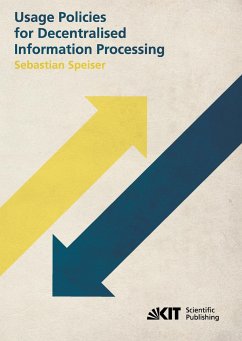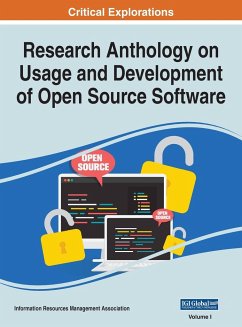
An Analysis of the Current Development Stage of the eXtensible Markup Language (XML) and its Usage for Database Systems
Versandkostenfrei!
Versandfertig in 1-2 Wochen
48,00 €
inkl. MwSt.

PAYBACK Punkte
0 °P sammeln!
Master's Thesis from the year 2002 in the subject Computer Science - Commercial Information Technology, grade: 1,0, University of Stirling (unbekannt), language: English, abstract: Inhaltsangabe:Abstract:The eXtensible Markup Language (XML) is receiving a great deal of attention from computing and Internet communities. This is mainly because of its ability to reduce obstacles in sharing data among diverse applications and databases by providing a common format for expressing data structure and content.The scope of this project is to investigate the current stage of XML and its usage for databa...
Master's Thesis from the year 2002 in the subject Computer Science - Commercial Information Technology, grade: 1,0, University of Stirling (unbekannt), language: English, abstract: Inhaltsangabe:Abstract:
The eXtensible Markup Language (XML) is receiving a great deal of attention from computing and Internet communities. This is mainly because of its ability to reduce obstacles in sharing data among diverse applications and databases by providing a common format for expressing data structure and content.
The scope of this project is to investigate the current stage of XML and its usage for database systems. In order to understand the XML database technology a general introduction to both database systems and XML is provided to the reader in chapter two and three. Chapter four and five deal with the methodology and findings of this project. These chapters rely on articles, case studies and surveys which are examined and evaluated. Finally, a conclusion and review chapter is included.
The analysis of the current adoption of XML among software developers revealed that in Spring 2001 more than one third of international developers already used XML. In 2001 they spent about 5.4% of their development time using XML. For 2002 it is predicted that they will spend an average of 9% of their development time using XML.
Concerning XML databases there are currently two major XML related database types available. These are native XML and XML enabled relational databases. Native XML databases are constructed to use the recommended XML standards to the most possible extent. Thereby, the XML document is the fundamental unit of storage. XML enabled relational databases are relational databases equipped with an additional layer to map XML content in to the relational tables. XML documents are only used as a means of transport between the database systems. Native XML databases are better suited for dealing with document structured content whilst XML enabled relational databases are more appropriate to handle data structured content such as numbers and pieces of text.
The implementation process of an XML related database system into an organisation requires the right management of change to be able to handle both the technology involved and the people affected by the database system. Therefore effective change management must cover the whole project life cycle from the formulation of the strategy to the achievement of the benefits.
Inhaltsverzeichnis:Table of Contents:
DISCLAIMERII
CONTENTSIII
LIST OF FIGURESVI
LIST OF TABLESVII
ABSTRACTVIII
CHAPTER 1: INTRODUCTION1
1.1Background to this Study1
1.2Research Question2
1.3Task Settings and Objectives3
1.4Dissertation Sections3
CHAPTER 2: DATABASE ENVIRONMENT5
2.1The Database Approach5
2.2Three Level Architecture6
2.3Database Languages8
2.4Data Modelling and Database Design9
2.5Relational Data Model11
2.6Data Normalisation14
CHAPTER 3: RESEARCH TOPIC17
3.1A Brief History About XML17
3.2Concept of XML18
3.2.1Logical and Physical Structure of an XML Document19
3.2.2Document Type Definition21
3.2.3Style Sheets21
3.3Additional XML Features23
3.4The Acceptance of XML24
3.5Technological XML Developments25
3.6Drawbacks of XML27
3.7Where is it All Going to?28
CHAPTER 4: XML AND DATABASES32
4.1Methodology32
4.2XML Related Databases33
4.3The Problem of Finding the Right Database for XML Content35
4.3.1Documents Versus Data36
4.4Native XML Databases Versus XML Enabled Relational Databases37
4.4.1Data Modelling38
4.4.2Retrieval Speed and Searching39
4.4.3Static Versus Dynamic Structures39
4.5An Evaluation Checklist40
4.6Assessing the Current XML Database Adoption42
4.7A Native XML Database as a Base for a Content Management ...
The eXtensible Markup Language (XML) is receiving a great deal of attention from computing and Internet communities. This is mainly because of its ability to reduce obstacles in sharing data among diverse applications and databases by providing a common format for expressing data structure and content.
The scope of this project is to investigate the current stage of XML and its usage for database systems. In order to understand the XML database technology a general introduction to both database systems and XML is provided to the reader in chapter two and three. Chapter four and five deal with the methodology and findings of this project. These chapters rely on articles, case studies and surveys which are examined and evaluated. Finally, a conclusion and review chapter is included.
The analysis of the current adoption of XML among software developers revealed that in Spring 2001 more than one third of international developers already used XML. In 2001 they spent about 5.4% of their development time using XML. For 2002 it is predicted that they will spend an average of 9% of their development time using XML.
Concerning XML databases there are currently two major XML related database types available. These are native XML and XML enabled relational databases. Native XML databases are constructed to use the recommended XML standards to the most possible extent. Thereby, the XML document is the fundamental unit of storage. XML enabled relational databases are relational databases equipped with an additional layer to map XML content in to the relational tables. XML documents are only used as a means of transport between the database systems. Native XML databases are better suited for dealing with document structured content whilst XML enabled relational databases are more appropriate to handle data structured content such as numbers and pieces of text.
The implementation process of an XML related database system into an organisation requires the right management of change to be able to handle both the technology involved and the people affected by the database system. Therefore effective change management must cover the whole project life cycle from the formulation of the strategy to the achievement of the benefits.
Inhaltsverzeichnis:Table of Contents:
DISCLAIMERII
CONTENTSIII
LIST OF FIGURESVI
LIST OF TABLESVII
ABSTRACTVIII
CHAPTER 1: INTRODUCTION1
1.1Background to this Study1
1.2Research Question2
1.3Task Settings and Objectives3
1.4Dissertation Sections3
CHAPTER 2: DATABASE ENVIRONMENT5
2.1The Database Approach5
2.2Three Level Architecture6
2.3Database Languages8
2.4Data Modelling and Database Design9
2.5Relational Data Model11
2.6Data Normalisation14
CHAPTER 3: RESEARCH TOPIC17
3.1A Brief History About XML17
3.2Concept of XML18
3.2.1Logical and Physical Structure of an XML Document19
3.2.2Document Type Definition21
3.2.3Style Sheets21
3.3Additional XML Features23
3.4The Acceptance of XML24
3.5Technological XML Developments25
3.6Drawbacks of XML27
3.7Where is it All Going to?28
CHAPTER 4: XML AND DATABASES32
4.1Methodology32
4.2XML Related Databases33
4.3The Problem of Finding the Right Database for XML Content35
4.3.1Documents Versus Data36
4.4Native XML Databases Versus XML Enabled Relational Databases37
4.4.1Data Modelling38
4.4.2Retrieval Speed and Searching39
4.4.3Static Versus Dynamic Structures39
4.5An Evaluation Checklist40
4.6Assessing the Current XML Database Adoption42
4.7A Native XML Database as a Base for a Content Management ...














